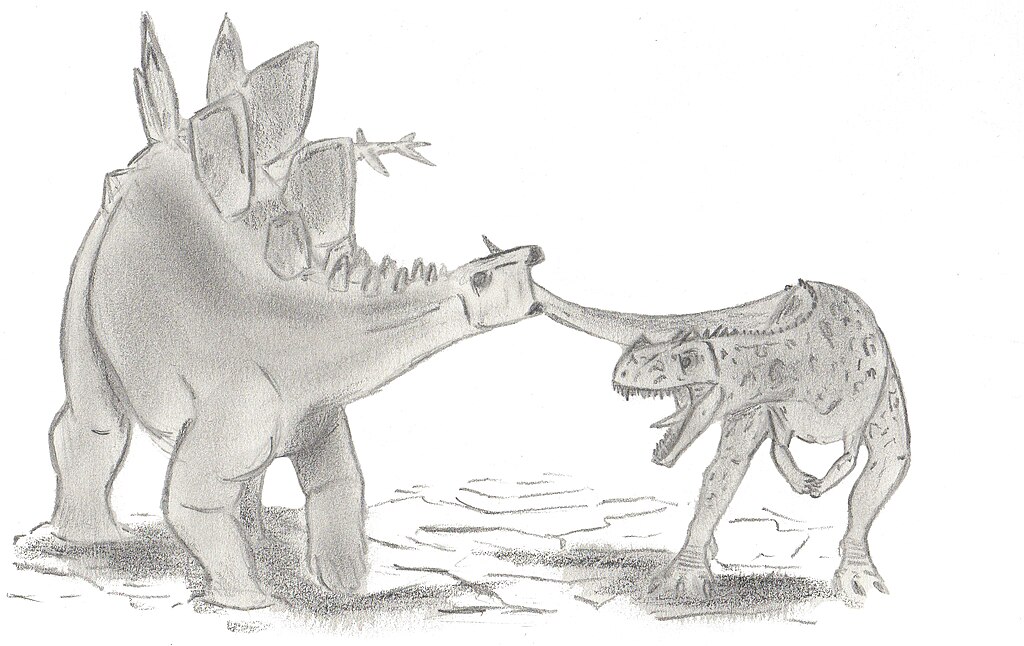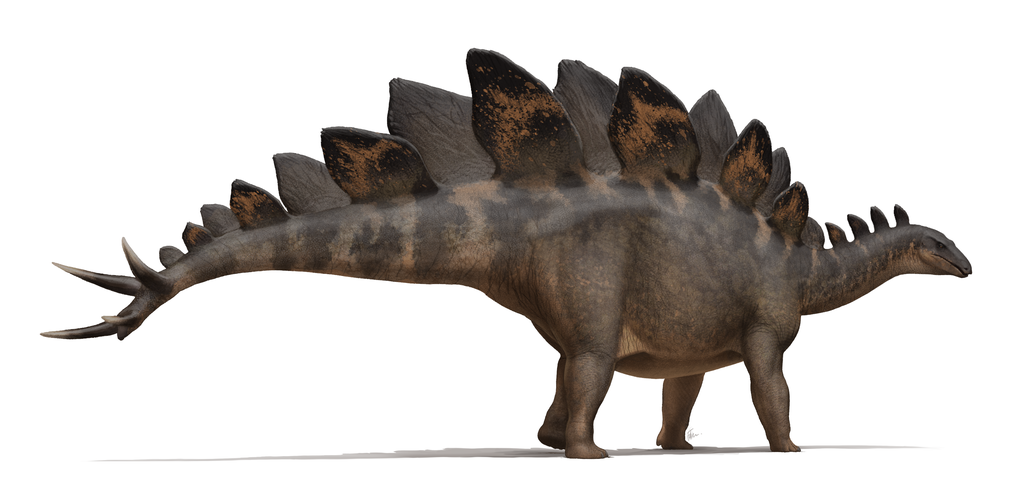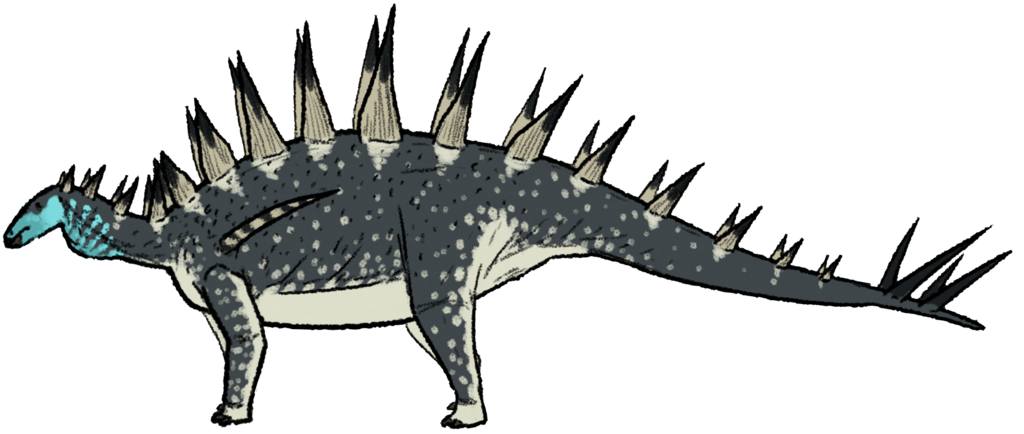The image of a stegosaurus, with its distinctive row of plates along its back and spiked tail, is one of the most recognizable dinosaur silhouettes in popular culture. These remarkable defensive adaptations have fascinated paleontologists and dinosaur enthusiasts alike for generations. The stegosaur’s tail spikes, known scientifically as a thagomizer, represent one of nature’s most effective prehistoric weapons. But why did these plant-eating dinosaurs evolve such dramatic defensive structures? The answer lies in a fascinating evolutionary tale of predator-prey relationships, survival adaptations, and the harsh realities of life during the Mesozoic Era. This article explores the science behind the stegosaur’s spiky tail and what these adaptations reveal about dinosaur ecology and behavior.
The Anatomy of a Thagomizer

The term “thagomizer” refers to the cluster of spikes found at the end of a stegosaur’s tail, though it wasn’t coined by scientists but rather by cartoonist Gary Larson in a 1982 “The Far Side” comic. These spikes weren’t simply bony protrusions but specialized osteoderms—bone structures that developed within the skin—that grew in pairs. In Stegosaurus, these spikes typically numbered four, arranged in two pairs, and could reach impressive lengths of up to 2-3 feet (60-90 cm). The spikes were made of bone but would have been covered with a keratin sheath in life, similar to modern animal horns, making them even sharper and more formidable than the fossilized bones suggest. Unlike the plates along the stegosaur’s back, which were relatively thin and flat, these tail spikes were solid, pointed, and clearly evolved as weapons rather than display structures.
Stegosaurs: More Than Just Stegosaurus

While Stegosaurus is the most famous member of the stegosaur family, it represents just one genus within a diverse group of dinosaurs called Stegosauria. This suborder included various genera such as Kentrosaurus, Huayangosaurus, Dacentrurus, and Lexovisaurus, among others, which lived across different parts of the world during the Jurassic and early Cretaceous periods. Not all stegosaurs had identical tail weapon arrangements; Kentrosaurus, for example, had pairs of spikes along its tail rather than just at the tip, making its entire tail a formidable weapon. Huayangosaurus, one of the earliest stegosaurs, had shorter but more numerous tail spikes. This diversity in tail weaponry suggests that different stegosaur species evolved specific defensive adaptations in response to their local predators and environmental pressures, demonstrating evolutionary specialization within the broader stegosaur group.
The Primary Purpose: Defense Against Predators

The most obvious and widely accepted function of the thagomizer was defense against predators. During the Late Jurassic period, when Stegosaurus roamed what is now western North America, these herbivores shared their habitat with fearsome carnivores like Allosaurus and Ceratosaurus. Being relatively slow-moving animals with small brains, stegosaurs couldn’t outrun or outsmart their predators and instead relied on physical deterrents. The tail spikes provided a powerful defensive weapon that could be swung with considerable force against an attacking predator. Computer models suggest that a Stegosaurus could swing its tail with enough force to pierce the skin and potentially damage the internal organs of an attacking Allosaurus. This defensive capability likely made potential predators think twice before attacking an adult stegosaur, as the risk of serious injury would have been significant.
Evidence of Thagomizer Effectiveness

Remarkable fossil evidence confirms that stegosaur tail spikes weren’t just for show but were actively used as weapons. One of the most compelling pieces of evidence comes from an Allosaurus vertebra discovered in the Morrison Formation of Wyoming, which shows a puncture wound that perfectly matches the shape and size of a Stegosaurus tail spike. The wound shows signs of healing, indicating that the Allosaurus survived the encounter but carried this battle scar for the remainder of its life. This fossil represents a rare and valuable “smoking gun” in paleontology—direct evidence of predator-prey interaction between two specific dinosaur species. Additional fossils showing similar damage patterns further support the theory that stegosaurs actively used their tail spikes in confrontations with predators, making the thagomizer one of the few dinosaur adaptations where we have direct evidence of its use.
Tail Mechanics and Mobility

The effectiveness of the thagomizer as a weapon depended on the stegosaur’s ability to maneuver its tail with precision and force. Recent studies of stegosaur tail vertebrae reveal adaptations that facilitated this defensive capability. Stegosaurs had relatively flexible tails with specialized musculature that allowed for surprising dexterity despite their large size. The vertebrae near the base of the tail were designed to accommodate powerful muscles that could generate significant force when swinging the tail. Computer modeling suggests that stegosaurs could swing their tails laterally with considerable speed and control, potentially striking predators approaching from the sides or rear. Some evidence indicates that certain stegosaur species may have even been able to hold their tails in a heightened, ready position for extended periods, allowing them to respond quickly to threats without expending excessive energy maintaining a constant defensive posture.
Intraspecific Combat: Fighting Other Stegosaurs

While defense against predators was likely the primary function of the thagomizer, some paleontologists suggest these weapons may have served a secondary purpose in competition between stegosaurs themselves. Many modern animals with defensive structures, such as antelope horns or deer antlers, use these features in intraspecific combat for territory or mating rights. Male stegosaurs may have engaged in competitive behaviors that involved tail displays or even direct combat with their tail spikes. Such behaviors would have established dominance hierarchies within stegosaur populations without necessarily resulting in serious injury, as the competitors would have evolved defensive behaviors against their own species’ weapons. Although direct fossil evidence for this behavior is currently lacking, the pattern is common enough among modern animals with defensive structures that it represents a plausible secondary function for the thagomizer.
Evolution of the Thagomizer

The thagomizer didn’t appear fully formed in the earliest stegosaurs but evolved gradually over millions of years through natural selection. Early stegosaur relatives had more modest tail defenses, with the specialized arrangement of large terminal spikes developing later in their evolutionary history. This progressive development reflects an evolutionary arms race between herbivorous dinosaurs and their predators, with defensive adaptations becoming more specialized and effective over time. The earliest known stegosaur, Huayangosaurus from Middle Jurassic China, had smaller, more numerous tail spikes compared to its later relatives. By the Late Jurassic, stegosaurs like Stegosaurus had evolved the classic arrangement of large, paired terminal spikes that proved most effective against the predators of their time. This evolutionary progression demonstrates how natural selection shaped these defensive structures in response to changing ecological pressures.
Stegosaur Plates vs. Tail Spikes

Stegosaurs are famous for two distinct sets of osteoderms: the plates along their backs and the spikes on their tails. While both were derived from similar developmental origins in the skin, they served different functions. The tall, thin plates along the back were primarily display structures and possibly thermoregulatory devices, with their large surface area allowing for heat exchange. They may have also presented a visual deterrent by making the dinosaur appear larger, but their thin structure made them poor defensive weapons. In contrast, the tail spikes were clearly offensive/defensive weapons, being solid, pointed, and positioned where they could be effectively wielded. This differentiation in form and function between plates and spikes within the same animal represents an excellent example of how similar structures can evolve for completely different purposes, demonstrating the versatility of evolutionary processes.
Stegosaur Tail Weapons Compared to Other Dinosaurs

Stegosaurs weren’t the only dinosaurs to evolve tail weapons, but their approach was distinctive. Ankylosaurs, another group of armored herbivores, evolved tail clubs rather than spikes, with a large, bony knob at the tail’s end that functioned as a bludgeoning weapon. These different approaches to tail weaponry represent convergent evolution—similar adaptations evolving independently in response to similar environmental pressures. Some sauropods like Shunosaurus had clubbed tails, while some hadrosaurs had stiffened tails that may have been used defensively. However, the stegosaur thagomizer was unique in its arrangement of large, paired spikes specifically designed for puncturing rather than bludgeoning. This diversity of tail weapons across different dinosaur lineages demonstrates how natural selection can produce various solutions to the same problem of defense against predators, with each dinosaur group evolving weaponry that complemented their overall body plan and ecological niche.
Thagomizers Across Different Stegosaur Species

The configuration of tail spikes varied significantly across different stegosaur species, reflecting their diverse evolutionary histories and ecological niches. Stegosaurus stenops, the most well-known species, typically had four large spikes arranged in two pairs. Kentrosaurus, an African stegosaur, had smaller plates along its back but featured numerous pairs of spikes running down its tail, essentially converting the entire tail into a defensive weapon rather than concentrating the weaponry at the tip. Tuojiangosaurus from China had particularly elongated tail spikes, while some species like Chungkingosaurus had proportionally smaller tail weapons. These variations likely reflect adaptations to different predator threats in their respective environments or different defensive strategies. Some species may have evolved spikes better suited for slashing, while others developed spikes optimized for piercing deeper into an attacker’s flesh, demonstrating how natural selection fine-tuned these weapons for specific ecological contexts.
Growth and Development of Tail Spikes

The development of thagomizers throughout a stegosaur’s life provides interesting insights into these animals’ growth and ecology. Juvenile stegosaurs had proportionally smaller and less developed tail spikes than adults, suggesting that young stegosaurs may have relied on different defensive strategies or parental protection before their weapons fully developed. Fossil evidence indicates that tail spikes continued to grow throughout much of a stegosaur’s life, potentially reaching their maximum size only in fully mature individuals. The growth pattern of these spikes, revealed through histological studies of the bone microstructure, shows similarities to the growth of horns and antlers in modern mammals, with periods of rapid development followed by slower growth. This pattern suggests that developing and maintaining these defensive structures required significant biological resources, emphasizing their importance to the animal’s survival strategy.
The Cultural Impact of the Thagomizer

The stegosaur’s thagomizer has had a remarkable impact on popular culture, extending far beyond scientific circles. The term itself represents a rare instance where scientific nomenclature originated in a cartoon, after Gary Larson’s “The Far Side” comic depicted a caveman lecturer pointing to the end of a Stegosaurus tail and informing his audience that this structure is called “the thagomizer, after the late Thag Simmons.” Though initially humorous, the term has been embraced by paleontologists and is now commonly used in scientific literature and museum exhibits. Stegosaurus tail spikes have become iconic elements in dinosaur toys, films, and artwork, often exaggerated for dramatic effect. This cultural penetration has made the thagomizer one of the most recognizable dinosaur features among the general public, alongside Tyrannosaurus rex’s teeth and Triceratops’ horns, demonstrating how distinctive adaptations can capture the imagination and become symbols that extend far beyond their biological significance.
Conclusion

The tail spikes of stegosaurs represent one of nature’s most successful defensive adaptations, proving effective enough that these dinosaurs thrived for over 25 million years across multiple continents. From their anatomical structure to their proven effectiveness against predators, these remarkable weapons provide a window into prehistoric predator-prey dynamics and the evolutionary arms race that shaped dinosaur development. The thagomizer demonstrates how natural selection can produce specialized adaptations in response to environmental pressures, creating structures perfectly suited to an animal’s survival needs. As we continue to study these fascinating dinosaurs through new fossil discoveries and advanced analytical techniques, our understanding of how and why stegosaurs wielded their iconic spiked tails continues to evolve, adding new chapters to one of paleontology’s most enduring stories.



